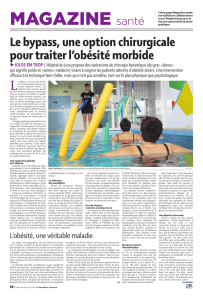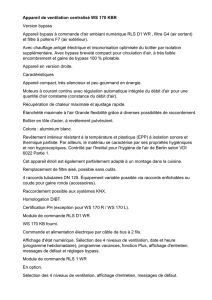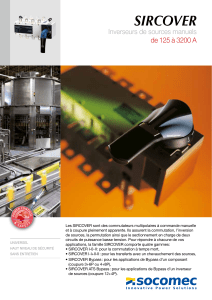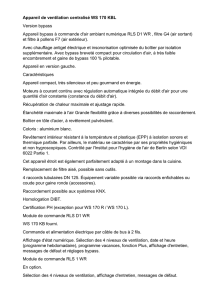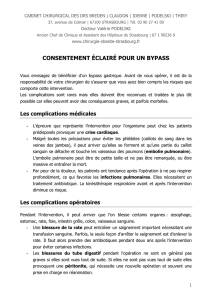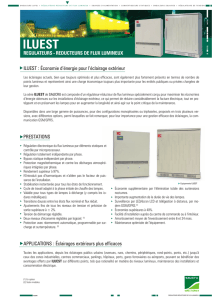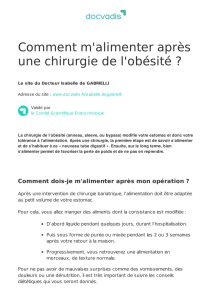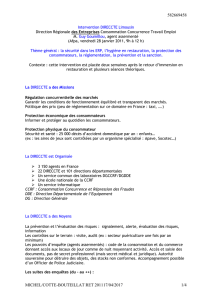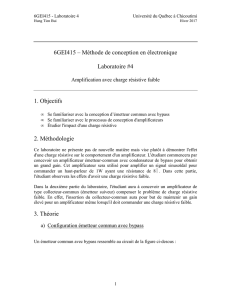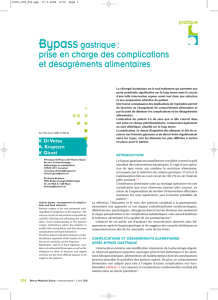ESTABILIZADOR DE TENSIÓN serie RE y
publicité
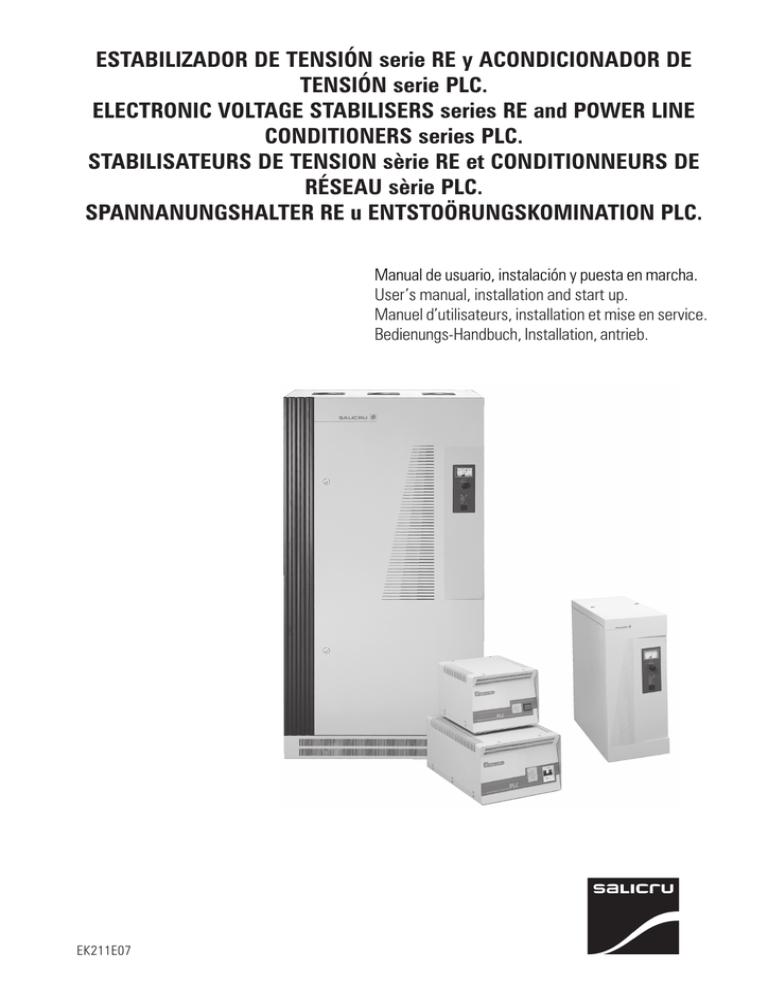
ESTABILIZADOR DE TENSIÓN serie RE y ACONDICIONADOR DE TENSIÓN serie PLC. ELECTRONIC VOLTAGE STABILISERS series RE and POWER LINE CONDITIONERS series PLC. STABILISATEURS DE TENSION sèrie RE et CONDITIONNEURS DE RÉSEAU sèrie PLC. SPANNANUNGSHALTER RE u ENTSTOÖRUNGSKOMINATION PLC. Manual de usuario, instalación y puesta en marcha. User’s manual, installation and start up. Manuel d’utilisateurs, installation et mise en service. Bedienungs-Handbuch, Installation, antrieb. EK211E07 AVISOS GENERALES DE SEGURIDAD . ....................................................................... 10 GENERAL SAFETY INSTRUCTIONS . ........................................................................... 20 CONSIGNES GÉNERAUX DE SÉCURITÉ . ................................................................... 30 ALLGEMEINE SICHERHEITSBESTIMMUNGEN AVISOS GERAIS DE SEGURANÇA . ............................................................................. 6 AVVERTIMENTI GENERALI DI SICUREZZA ÁLTALÁNOS ÓVINTÉZKEDÉSEK . ...................................................... 40 . ............................................................. 6 . ................................................................................ 7 VŠEOBECNÉ BEZPEÈNOSTNÍ POKYNY . ..................................................................... 8 Manual de usuario, instalación y puesta en marcha...............................................9-17 User’s manual, installation and start up. ...............................................................19-27 Manuel d’utilisateurs, installation et mise en service. ............................................29-37 Bedienungs-Handbuch, Installation, antrieb. ..........................................................39-47 -2- Les agradecemos de antemano, la confianza depositada en nosotros al adquirir este producto. Lean este manual de instrucciones cuidadosamente antes de poner en marcha el equipo y guardenlo para futuras consultas que puedan surgir. Quedamos a su entera disposición para toda información suplementaria o consultas que deseen realizarnos. Atentamente les saluda. SALICRU Siguiendo nuestra política de constante evolución, nos reservamos el derecho de modificar las características total o parcialmente sin previo aviso. Queda prohibida la reproducción o cesión a terceros de este manual, sin previa autorización por escrito por parte de nuestra firma. We would like to thank you in advance for the trust you haveplaced in us by purchasing this equipment. Carefully read the instructions of this Manual befores starting up the equipment and save it for future consultations. Please do not doubt to contact with us us for any additonal information or for consulsations you would like to discuss wuith us. Many thanks. SALICRU Following its policy of continuous development, reserves teh right to modify any of the specifications, totally or partially, without prior notice. The reproduction of this manual or its transfer to third parties is prohibited without prior written authorisation from our company. -3- Nous vous remercions d’avance d’avoir bien voulu déposer votre confiance en nous en acquérant ce produit. Lisez attentivement ce manuel d’instructions avant de mettre l’équipement en marche puis conservez le de façon à pouvoir le consulter dans de futures occasions. Nous restons à votre disposition pour toute information supplémentaire au consultations dont vous auriez besoin. Salutations distinguées. SALICRU Fidèle à sa politique d’évoultion constante, se réserve le droit de modifier sans préavis les caractéristiques des appareils, en totalité ou en partié. La reproduction ou la cession de ce manuel à des tiers sans l’autorisation écrite de la nôtra firm sont rigouresement interdites. Wir danken Ihnen im voraus für das vertrauen, das Sie uns mit dem Kauf dieses Produkts erwiesen haben. Die vorliegenden Anweisungen sollten Sie vor Inbetriebnahme des Geräts aufmerksam durchlesen und dann für spätere Zweifelsfälle sorsgsam aufbewahren. Für weitere Auskunft und Rückfragen stehen wir ihnen jederzeit gern zur Verfügung. Mit freundlichen Grüenßen. SALICRU Die Fa., behält man sich vor, Teil-bzw. Gesamtänderung ohne jeder Ankündigung, von den hier angegebenen Merkmalen, durchzuführen. Die Vielfältigung oder Weitergabe dieses Handbuch an Dritte ohne eine schriftliche Genehmigung its untersagt. -4- -5- AVISOS GERAIS DE SEGURANÇA. • Os estabilizadores de tensão RE2 e os acondicionadores de linha PLC2 devem ser considerados como transformadores ou linhas de distribuição no que se refere à instalação e segurança eléctricas. Estes aparelhos são "transparentes" à tensão de entrada. Por outro lado deve-se considerar que, se o equipamento incorpora By-pass (equipamentos com a configuração segundo a figura 2) com rede presente, este fornece tensão directamente da rede comercial, sem estar necessariamente ligado o interruptor (6). Para cortar o fornecimento, deve abrir-se o disjuntor (5). • Deve-se conectar obrigatoriamente a ligação, à terra de protecção, assegurando-se que esta se realiza antes de ligar a tensão à entrada do RE2 ou PLC2. Para aparelhos pequenos (ligados com condutor previsto com ficha de tomada) o utilizador deve-se assegurar que a tomada de corrente seja correspondente à ficha fornecida, com ligacão de terra devidamente instalada e ligada à terra de protecção do local. Para os restantes aparelhos (providos de bornes), o instalador deve ligar o condutor de terra ao borne correspondente. • No interior do equipamento existem tensões perigosas, pelo que o acceso deve ser fectuado por pessoal autorizado e competente. Em caso de manutenção ou avaria consultar o serviço de Pós-Venda mais próximo. • A instalação dos RE2 e/ou PLC2 equipados com bornes, deve ser efectuada por pessoal qualificado, em instalações eléctricas de baixa tensão. • A estabilização realiza-se independentemente entre fases. Se existe desequilíbrio de tensão na rede trifásica ou desequilíbrio nas cargas, a tensão entre fases à saída pode não ser igual; não obstante, será conservada a estabilização entre fases e neutro. • É indispensável a ligação do neutro de entrada nos estabilizadores de tensão trifásicos RE2. Esta permissa não é aplicável a equipamentos trifásicos PLC2 (estabilizadores de tensão providos de transformador separador com isolamento galvânico). • Os PLC2 (estabilizadores de tensão providos de transformador separador com isolamento galvânico) podem ser ligados com o regime de neutro que se deseje. Para o regime de neutro isolado, deve-se suprimir o condutor ponte, que liga um borne de saída ao borne de terra. AVVERTIMENTI GENERALI DI SICUREZZA. • Gli stabilizzatori di tensione RE2 ed i condizionatori della linea PLC2 si devono considerare come trasformatori o linee di distribuzione dal punto di vista dell’installazione e della sicurezza elettrica. Questi apparecchi sono “trasparenti” alla tensione d’entrata. D’altra parte si deve considerare che se l’impianto incorpora by-pass (impianti con struttura come nella figura 2), con rete presente, questo fornisce tensione d’uscita direttamente dalla rete elettrica, senza che l’interruttore (6) debba essere necessariamente acceso. Per interrompere il flusso elettrico si deve aprire l’interruttore termomagnetico (5). -6- • È obbligatorio effettuare il collegamento di protezione a terra, accertandosi che ciò sia così prima di collegare la tensione all’entrata del RE2 o del PLC2. Per gli apparecchi piccoli (collegabili con il cavo dotato di spina), l’utente deve accertarsi che la presa di corrente corrisponda alla spina fornita, con presa di terra debitamente installata e collegata alla terra di protezione del locale. Per gli altri apparecchi (dotati di terminali), l’installatore deve collegare il cavo di terra al terminale corrispondente. • All’interno dell’apparecchio ci sono tensioni pericolose. Per tale motivo, vi devono accedere solo persone autorizzate e competenti. Per le operazioni di manutenzione o in caso di avaria, rivolgersi al Servizio Postvendita più prossimo. • L’installazione degli RE2 e/o dei PLC2 dotati di terminali deve essere effettuata da personale qualificato, esperto in impianti elettrici a bassa tensione. • La stabilizzazione si realizza indipendentemente tra le fasi. Se esiste un’oscillazione di tensione nella rete trifase o uno squilibrio nelle cariche, la tensione tra le fasi all’uscita può non essere uguale. Si conserverà tuttavia la stabilizzazione tra le fasi e il neutro. • È indispensabile il collegamento del neutro di entrata negli stabilizzatori a tensione trifase RE2. Questa premessa non è applicabile agli apparecchi trifase PLC2 (stabilizzatori di tensione dotati di trasformatore separatore con isolamento galvanico). • I PLC2 (stabilizzatori di tensione dotati di trasformatore separatore con isolamento galvanico) possono essere collegati con il regime di neutro che si desideri. Per un regime a neutro isolato, si deve sopprimere il ponte di filo che va dal terminale di uscita al terminale di terra. ÁLTALÁNOS ÓVINTÉZKEDÉSEK. • Az RE2 feszültségstabilizátorok és a PLC2 vonalkondicionálók telepitési szempontból transzformátornak vagy hálózati elosztónak minõsülnek. Ezek a bemenõ feszültségnek. Más szempontból a By-passl ellátott berendezés feszültség meglétekor képes a kimenetén fogyasztókat kiszolgálni anélkül, lenne kapcsolva. Az áramellátás megszûntetéséhez az (5) kismegszakítót és elektromos biztonsági a készülékek "átlátszóak" (lásd 2. ábra) a hálózati hogy a (6) kapcsoló be ki kell kapcsolni. • Kötelezõen védõfõldeléssel kell ellátni az RE2 vagy PLC2 készülékeket mielõtt feszültség alá helyezik ezek bemenetét. Kis készülékek estén (dugós vezetékkel csatlakoztathatók a felhasználónak kell megbizonyosodnia, hogy a csatlakozó dugalj megfelel -e a követelményeknek, kötelezõen el van -e látva helyesen bekötött védõföldeléssel. Nagyobb készülékek esetén (sorkapoccsal csatlakoztathatók) a földvezetéket a megfelelõ sorkapocs ponthoz kell kötnie a telepítõnek. • A készülék belsejében életveszélyes feszültség uralkodik, a készülékbe csak engedélyezett és képzett személy nyithat. Karbantartás vagy hiba esetén forduljon a képviseletéhez. -7- • A sorkapocs bekötésû RE2-k és/vagy PLC2-k telepítését csak villamos szakképzettséggel rendelkezõ, betanított személy végezheti. • A fázisok kõzõtt egymástól független a stabilizálás. Ha a háromfázisú hálózat, vagy a terhelés aszimmetrikus, elképzelhetõ, hogy a kimenetre jutó fázisok közötti feszültség nem azonos, habár a stabilizálás fázis és nulla között jön létre. • A háromfázisú RE2 feszültségstabilizátorokon nélkülözhetetlen a bemeneti nullának a csatlakoztatása, ez a követelmény nem vonatkozik a háromfázisú PLC2 berendezésekre (galvanikus szigetelésû leválasztó trafóval ellátott stabilizátorok). • A PLC2-k (galvanikus szigetelésû leválasztó trafóval ellátott stabilizátorok) tetszõleges nullávall csatlakoztathatók. Szigetelt nullához meg kell szüntetni a vezetékhidat, mely egy kimeneti sorkapocs ponttól a fõld sorkapocs pontig megy. VŠEOBECNÉ BEZPEÈNOSTNÍ POKYNY. • Stabilizátory napìtí RE2 a stabilizátory PLC2 (s oddìlovacím transformátorem) jsou z hlediska elektroktrotechnických bezpeènostních pøedpisù sít'ové transformátory zapojené do rozvodné sítì. Tìmito zaøízeními volnì protéká proud závislý na vstupním napìtí a odporu spotøebièe. Pokud je v zanízení zapojen Bypass (u zaøízení podle obr. 2) a je pøipojeno k síti, na výstupu z nìj je sít'ové napìtí ani•by musel být zapnut vypínaè (6). Napájení spotøebièù zaøízením se vypne jistièem (5). • Pøed pøipnutím stabilizátorù RE2 i PLC2 k síti, musí být tato zaøízení bezpodmíneènì uzemnìna. Malá zaøízení, pøipojovaná k síti zástrèkou, musí být napájena ze zásuvky tvarovì odpovídající zástrèce a se správnì pøipojeným uzemnìním. U ostatních zaøízení, pøipojovaných prostøednictvím svorkovnice, musí být zemnící vodiè pøipojen na odpovídající svorku. • Uvnitø tìchto zaøízení jsou •ivotu nebezpeèná napìtí a proto do nich mohou zasahovat pouze znalé a povìøené osoby s pøíslušnou kvalifikací. V pøípadé poruchy zaøízení nebo jeho údr•by, obracejte se v•dy na znaèkový servis povìøený výrobcem, firmou . • Stabilizátory napìtí RE2 a PLC2, opatøené svorkovnicí, mohou pøipojovat k elektrické síti pouze osoby znalé s pøíslušnou odbornou zkouškou. • Zaøízení stabilizují napìtí jednotlivých fází nezávisle na sobì. Jestili•e jsou v tøífázové sítí nevyvá•ená napìtí a zati•ení fází, mohou být na výstupu rùzná sdru•ená napìtí (napìtí mezi fázemi). Stabilizace fázového napìtí (napìtí mezi fázemi a N) však zùstává zachována. • Tøifázové stabilizátory RE2 musí být v•dy pøipojeny k nulovému vodièi sítì. Toto neplatí pro stabilizátory PLC2 s oddìlovacím transformátorem. • Stabilizátory PLC2 s oddìlovacím transformátorem je mo•no zapojovat do sítì s nulovým vodièem jakkoliv. Pøi zapojování do sítì s oddìlenou nulou, musí se na svorkovnici odstranit propojení výstupní svorky se svorkou zemnící. -8- Índice general. 1.- VISTAS DE LOS RE2 o PLC2 Y CONTROLES. (Figuras 4,5 y 6). 2.- LEYENDAS CORRESPONDIENTES A LAS VISTAS DE LOS EQUIPOS. 3.- AVISOS GENERALES DE SEGURIDAD. 4.- ESQUEMAS DE BLOQUES. 5.- INSTALACIÓN. 5.1.- Conexión a la red. 5.2.- Conexión de la salida. 6.- PUESTA EN FUNCIONAMIENTO Y PARO DEL EQUIPO. 6.1.- Puesta en marcha de un equipo con estructura según figura 1. 6.2.- Puesta en marcha de un equipo con estructura según figura 2. 6.3.- Paro de un equipo con estructura según figura 1. 6.4.- Paro de un equipo con estructura según figura 2. 7.- PUESTA EN MARCHA Y PARO DE UN EQUIPO CON OPCIONAL DE PROTECCIONES DE MÁXIMA-MÍNIMA TENSIÓN. 7.1.- Versión automático (MR) y manual (M). Puesta en marcha equipo con estructura según figura 1. 7.2.- Versión automático (MR) y manual (M). Puesta en marcha equipo con estructura según figura 2. 7.3.- Anulación - Activación de las protecciones de máxima-mínima. 7.4.- Paro de un equipo con protecciones de máxima-mínima. 8.- INTERFACE . 9.- CARACTERISTICAS TÉCNICAS COMUNES. 10.- CARACTERÍSTICAS TÉCNICAS SEGÚN MODELO. -9- 1.- VISTAS DE LOS RE2 o PLC2 Y CONTROLES. (Figuras 4,5 y 6). En las figuras 4, 5 y 6 se han contemplado las vistas de todos los formatos con sus distintos motajes según modelo. Debe de escogerse la vista correspondiente al equipo adquirido. 2.- LEYENDAS CORRESPONDIENTES A LAS VISTAS DE LOS EQUIPOS. (1) (2) (3) (4) (5) (6) (7) (8) (9) (10) (11) (A) (B) (C) (D) (E) (a) (b) (c) (d) (e) (f) (g) (h) 3.- Clavija o bornes alimentación de entrada. Bases o bornes de salida. Conector interface a relés (Opcional). Fusibles de entrada (a y b). Interruptor o magnetotérmico general de entrada. Interruptor - . Voltímetro de salida. Conmutador voltímetro (Equipos trifásicos). Fusible o interruptor anular protecciones. (Sólo en equipos con ópcional máx-mín). Cerradura puerta armario. Bornes toma de tierra ( ). Sinóptico tipo (A). Sinóptico tipo (B). Sinóptico tipo (C). Sinóptico tipo (D) (Equipos con máx.-mín.). Sinóptico tipo (E) (Equipos con máx.-mín.). Entrada "Input". Marcha "Power on". Bypass A (R) "Bypass A (R)". Bypass B (S) "Bypass B (S)". Bypass C (T) "Bypass C (T)". Salida "Output". Fuera de servicio "Out of Service" (Sólo en equipos con opcional máx.-mín.) . Marcha protecciones máx.-min. en versión M "Reset". (Equipos con máx.-mín.). AVISOS GENERALES DE SEGURIDAD. • Los estabilizadores de tensión RE2 y acondicionadores de línea PLC2 deben considerarse como transformadores o líneas de distribución desde el punto de vista de la instalación y seguridad eléctricas. Estos aparatos son "transparentes" a la tensión de entrada. Por otra parte debe considerarse que si el equipo incorpora Bypass (equipos con estructura según figura 2), con red presente, éste suministra tensión de salida directamente de la red comercial, sin estar necesariamente en marcha el interruptor (6). Para cortar el suministro debe abrirse el interruptor magnetotérmico (5). - 10 - • Debe conectarse obligatoriamente la conexión al tierra de protección, asegurándose que ello se realiza antes de conectar la tensión a la entrada del RE2 o PLC2. Para los aparatos pequeños (conectables con cordón provisto de clavija de enchufe), el usuario debe asegurarse que la toma de corriente se corresponde al tipo suministrado, con toma de tierra debidamente instalada y conectada a la tierra de protección del local. Para los demás aparatos (provistos de bornes), el instalador debe conectar el hilo de tierra al borne correspondiente. • En el interior del equipo existen tensiones peligrosas, el acceso debe efectuarse por personas autorizadas y competentes. En caso de mantenimiento o avería, consultar al Servicio de Asistencia Técnica (SAT) más próximo. • La instalación de los RE2 y/o PLC2 equipados con bornes debe efectuarla personal cualificado en instalaciones eléctricas de baja tensión. • La estabilización se realiza independientemente entre fases. Si existe desequilibrio de tensión en la red trifásica o desequilibrio en las cargas, la tensión entre fases a la salida puede ser que no sea igual; sin embargo se conservará la estabilización entre fases y neutro. • Es indispensable la conexión del Neutro de entrada en los estabilizadores de tensión trifásicos RE2; esta premisa no es aplicable para los equipos trifásicos PLC2 (estabilizadores de tensión provistos de transformador separador con aislamiento galvánico). • Los PLC2 (estabilizadores de tensión provistos de transformador separador con aislamiento galvánico) pueden conectarse con el régimen de neutro que se desee. Para régimen de neutro aislado, debe de suprimirse el puente de hilo que va de un borne de salida al borne de tierra. - 11 - 4.- ESQUEMAS DE BLOQUES. Marcha Protección entrada Trafo tomas Interruptores Trafo estáticos separador (Opcional) Paro (Stand-by) Protección entrada Protecciones máx.-mín. (Opcional) Trafo tomas Interruptores Trafo estáticos separador (Opcional) On/Standby Voltímetro Control Bypass Control Protecciones máx.-mín. (Opcional) Fig. 2. Equipos en caja o armario según fig. 5 ó 6. Fig. 1. Equipos en caja según fig. 4. 5.- INSTALACIÓN. • Revisar los avisos generales de seguridad. • Comprobar que los datos de la placa de características son los requeridos para la instalación. • Siempre se realizarán las conexiones sin red eléctrica presente. • La ubicación será espaciosa, aireada y de fácil acceso. Jamás a la intemperie. • Nunca se obstruirán los taladros de ventilación. • El RE2 o PLC2 debe tener el interruptor de puesta en marcha (6) a posición ( ) y el interruptor (5) desconectado. • Las secciones de los cables de alimentación y de salida estarán en consonancia con la corriente nominal de la placa de características, respetando el Reglamento Electrotécnico de Baja Tensión local. • Para los modelos con cable enchufable (1) deben de instalarse con tomas de corriente (enchufes) del tipo con toma de tierra y estar correctamente instalados. 5.1.- Conexión a la red. • Debe conectarse obligatoriamente la conexión a tierra, asegurándose que ello se realiza antes de conectar la tensión a la entrada del RE2 o PLC2. • Conectar la clavija o bornes de entrada (1) según modelo, a la red de alimentación sin que exista tensión. - 12 - 5.2.- Conexión de la salida. • Los régimenes de neutro de la entrada a la salida son idénticos "sin aislamiento galvánico" para los estabilizadores de tensión RE2. Los acondicionadores de línea PLC2 pueden conectarse con el régimen de neutro que se desee. Para régimen de neutro aislado, debe de suprimirse el puente de hilo que va de un borne de salida al borne de tierra. • Conectar las cargas críticas a las bases o bornes de salida (2) según modelo. 6.- PUESTA EN FUNCIONAMIENTO Y PARO DEL EQUIPO. • Verificar que se ha respetado lo indicado en el capítulo 5 de Instalación. • Cercionarse que los fusibles de entrada (4a y 4b) estén colocados en los modelos que corresponda. • Aplicar tensión de red comercial a la entrada del equipo. El led (a) "Input", se ilumina. 6.1.- Puesta en marcha de un equipo con estructura según figura 1. • Accionar el interruptor (5) a posición "On" o "I", el equipo suministra tensión de salida estabilizada. Los leds (b) "Power on" y (f) "Output", se iluminan. La puesta en marcha diaria del equipo, se realiza a través de este interruptor (5). • Si se iluminan alguno de los leds (c) "Bypass A (R)", (d) "Bypass B (S)" y (e) "Bypass C (T)", ponerse en contacto con el Servicio de Asistencia Técnica (SAT). El equipo puede permanecer conectado, aunque no estabiliza, sí suministra una tensión límpia de ruidos eléctricos en el caso de un acondicionador de línea PLC2. 6.2.- Puesta en marcha de un equipo con estructura según figura 2. • Accionar el interruptor (5) a posición "On" o "I", el equipo suministra tensión de salida directamente de la red comercial a través del Bypass. El led (f) "Output", se ilumina. • Desde el momento que se ha aplicado la tensión de red comercial y el interruptor (5) está conectado, la tensión está presente en los bornes de salida a través del Bypass. • Accionar el interruptor (6) a posición ( ), el equipo suministra tensión de salida estabilizada. El led (b) "Power on", se ilumina. También se iluminan durante unos instantes los leds (c) "Bypass A (R)", (d) "By-pass B (S)" y (e) "Bypass C (T)", indicación de auto-test. La puesta en marcha diaria del equipo, se realiza a través de este interruptor (6). • Mediante el voltímetro (7) se puede verificar la tensión en bornes de salida, ya bien cuando es proveniente de la red comercial a través del Bypass o cuando es estabilizada a partir del equipo. Además, en los equipos trifásicos se dispone de un conmutador de voltímetro (8) que permite seleccionar la tensión entre fase y neutro o entre fases a analizar en el voltímetro (7). - 13 - • Si se iluminan alguno de los leds (c) "Bypass A (R)", (d) "Bypass B (S)" y (e) "Bypass C (T)" simultaneamente con una alarma acústica es sinónimo de sobrecarga o avería. Parar el equipo completamente, rebajar la carga conectada a los bornes de salida y volverlo a poner en marcha. De persistir, ponerse en contacto con el Servicio de Asistencia Técnica (SAT). El equipo puede permanecer conectado, aunque no estabiliza, sí suministra una tensión límpia de ruidos eléctricos en el caso de un acondicionador de línea PLC2. 6.3.- Paro de un equipo con estructura según figura 1. • Accionar el interruptor (5) a posición "Off" o "0". El equipo queda completamente parado. Sólo luce el led (a) "Input". El paro diario del equipo, se realiza a través de este interruptor (5). 6.4.- Paro de un equipo con estructura según figura 2. • Accionar el interruptor (6) a posición ( ). El equipo suministra tensión de salida a partir del Bypass. Permanecen iluminados los led (a) "Input" y (f) "Output". El paro diario del equipo, se realiza a través de este interruptor (6). • Desde el momento que se ha aplicado la tensión de red comercial y el interruptor (5) está conectado, la tensión está presente en los bornes de salida a través del Bypass. • Accionar el interruptor (5) a posición "Off" o "0". El equipo queda completamente parado. Sólo luce el led (a) "Input". 7.- PUESTA EN MARCHA Y PARO DE UN EQUIPO CON OPCIONAL DE PROTECCIONES DE MÁXIMA-MÍNIMA TENSIÓN. • Básicamente se trata de un detector que garantiza el suministro de tensión de salida, siempre y cuando la misma corresponda a los márgenes preajustados de fábrica. • Verificar que se ha respetado lo indicado en el capítulo 5 de Instalación. • Aplicar tensión de red comercial a la entrada del equipo. El led (a) "Input", se ilumina. 7.1.- Versión automático (MR) y manual (M). Puesta en marcha equipo con estructura según figura 1. • Accionar el interruptor (5) a posición "On" o "I". Los leds (b) "Power on", (f) "Output" y (g) "Out of Service", se iluminan. Versión automático (MR): Transcurridos unos segundos, si la tensión está dentro de los márgenes preajustados, el detector conecta la salida y se apaga el led (g) "Out of Service", el equipo suministra tensión de salida estabilizada. El pulsador (h) "Reset", no es operativo en esta versión de protecciones. Versión manual (M): Presionar el pulsador (h) "Reset" durante unos segundos hasta que se apage el led (g) "Out of Service", el equipo suministra tensión de salida estabilizada. Puede suceder que al dejar de presionar sobre el pulsador (h) "Reset", el equipo retorne a la posición "Out of Service". Esto indica que la tensión está fuera de los márgenes preajustados, o bien que el tiempo en que se ha presionado el pulsador ha sido insuficiente; repetir el proceso. • Atención: La iluminación del led (g) "Out of Service"indica que no existe tensión de alimentación en los bornes de salida (2). - 14 - • La puesta en marcha diaria del equipo, se realiza a través de este interruptor (5). • Si se iluminan alguno de los leds (c) "Bypass A (R)", (d) "Bypass B (S)" y (e) "Bypass C (T)", ponerse en con-tacto con el Servicio de Asistencia Técnica (SAT). El equipo puede permanecer conectado, aunque no estabiliza, sí suministra una tensión límpia de ruidos eléctricos en el caso de un acondicionador de línea PLC2. 7.2.- Versión automático (MR) y manual (M). Puesta en marcha equipo con estructura según figura 2. • Accionar el interruptor (5) a posición "On" o "I". El led (f) "Output" y (g) "Out of Service", se iluminan. Versión automático (MR): Transcurridos unos segundos, si la tensión está dentro de los márgenes preajustados, el detector conecta la salida y se apaga el led (g) "Out of Service", el equipo suministra tensión directa de la red a través del Bypass. Accionar el interruptor (6) a posición ( ), el equipo suministra tensión de salida estabilizada siempre y cuando la misma corresponda a los márgenes preajustados de fábrica. El led (b) "Power on", se ilumina. También se iluminan durante unos instantes los leds (c) "Bypass A (R)", (d) "Bypass B (S)" y (e) "Bypass C (T)", indicación de auto-test. El pulsador (h) "Reset", no es operativo en esta versión de protecciones. Versión manual (M): Accionar el interruptor (6) a posición ( ), el equipo está en disposición de suministra tensión de salida estabilizada. El led (b) "Power on", se ilumina. También se iluminan durante unos instantes los leds (c) "Bypass A (R)", (d) "Bypass B (S)" y (e) "Bypass C (T)", indicación de auto-test. Presionar el pulsador (h) "Reset" durante unos segundos hasta que se apage el led (g) "Out of Service", el equipo suministra tensión de salida estabilizada. Puede suceder que al dejar de presionar sobre el pulsador (h) "Reset", el equipo retorne a la posición "Out of Service". Esto indica que la tensión está fuera de los márgenes preajustados, o bien que el tiempo en que se ha presionado el pulsador ha sido insuficiente; repetir el proceso. • Desde el momento que se ha aplicado la tensión de red comercial y el interruptor (5) está conectado, la tensión está presente en los bornes de salida a través del Bypass. • Atención: La iluminación del led (g) "Out of Service" indica que no existe tensión de alimentación en los bornes de salida (2), aunque el voltímetro (7) interno del estabilizador indica tensión. • La puesta en marcha diaria del equipo, se realiza a través de este interruptor (6). • Si se iluminan alguno de los leds (c) "Bypass A (R)", (d) "Bypass B (S)" y (e) "Bypass C (T)" simultaneamente con una larma acústica es sinónimo de sobrecarga o avería. Parar el equipo completamente, rebajar la carga conectada a los bornes de salida y volverlo a poner en marcha. De persistir, ponerse en contacto con el Servicio de Asistencia Técnica (SAT). El equipo puede permanecer conectado, aunque no estabiliza, sí suministra una tensión límpia de ruidos eléctricos en el caso de un acondicionador de línea PLC2. 7.3.- Anulación - Activación de las protecciones de máxima-mínima. • Para anular las protecciones, colocar el fusible que se sirve junto con el equipo en su alojamiento (9) o seleccionar la posición "Off" mediante el conmutador (9). Y para activar las protecciones, retirar el fusible del alojamiento (9) o seleccionar la posición "On" mediante el conmutador (9). 7.4.- Paro de un equipo con protecciones de máxima-mínima. • Para el paro del equipo, operar de acuerdo al apartado 6.3 ó 6.4 según sea la estructura del equipo. - 15 - 8.- INTERFACE . • El interface a relés hace posible un diálogo entre el RE2 o PLC2 y el mundo exterior. Se dispone mediante los contactos conmutados de tres relés de la información de Bypass de cada fase, en un mismo conector (3.1) o regleta de bornes (3.2). • La línea de comunicaciones (interface) constituye un circuito de muy baja tensión de seguridad. Para conservar su cualidad debe instalarse separada de otras líneas que lleven tensiones peligrosas (líneas de distribución de energía). Pin 1. Pin 2. Pin 6. Pin 7. Pin 8. Pin 3. Pin 4. Pin 5. Pin 9. Contacto NC Bypass A (fase R). Contacto NO Bypass A (fase R). Común Bypass A (fase R). Contacto NC Bypass B (fase S). Contacto NO Bypass B (fase S). Común Bypass B (fase S). Contacto NC Bypass C (fase T). Contacto NO Bypass C (fase T). Común Bypass C (fase T). Corriente y tensión máximas en contactos relés 2A 30V D.C. ó 0.6A 125V A.C. 1 6 5 9 Fig. 3.1. Conector (3) SUB D9. 6 3 9 1 7 4 2 8 5 Fig. 3.2. Regleta de bornes (3) SUB D9. 9.- CARACTERISTICAS TÉCNICAS COMUNES. Tensión de red de alimentación monofásica o trifásica: .................. 195,5 a 264,5 V ó 3 x 340 a 460 V. Frecuencia de red: ............................................................................ 48 a 63 Hz. Tensión de salida monofásica o trifásica: ......................................... 230 V ±2 % ó 3 x 400 V ±2 %. Frecuencia de salida: ........................................................................ 48 a 63 Hz. Sobrecarga admisible: ..................................................................... 100 % durante 1 min., 200 % durante 20 s. y 1000% durante 50 ms. Distorsión: ........................................................................................ Nula. Rendimiento típico: .......................................................................... 0,90 ÷ 0,98 según modelo. Ruido acústico: ................................................................................. ≤ 35 dB. Ambientales de trabajo: ................................................................... Temperatura -10 a 45 ºC, Humedad 10 a 95 %. Atenuación ruidos eléctricos en modo común (Opcional): ............. PLC2 con trafo separador (T) > 40dB. PLC2 con trafo ultra-aislamiento (NS) > 120dB. Protecciones de máx.-mín. (M) o (MR) (Opcional): ....................... Preajustado en fábrica a tensión nominal ±7,5%. Conformidad a normas: ................................................................. EN 60950. - 16 - 10.- CARACTERÍSTICAS TÉCNICAS SEGÚN MODELO. MODELO RE2 RE 309-2 RE 609-2 RE 1009-2 RE 2009-2 RE 3009-2 RE 4509-2 RE 6009-2 RE 9009-2 RE 12009-2 RE 15009-2 RE 20009-2 RE 25009-2 RE 30009-2 RE 40009-2 RE 50009-2 RET 3-4 RET 6-4 RET 9-4 RET 15-4 RET 20-4 RET 30-4 RET 45-4 RET 60-4 RET 75-2 RET 100-4 RET 125-4 RET 150-4 ESTRUCTURA (según fig. 1 ó 2) 1 1 1 1 1 1 1 1 1 1 1 1 1 1 1 1 1 1 1 1 1 1 1 1 1 1 1 MODELO PLC2 POTENCIA-SALIDA (kVA - kW) 0,3 0,6 1 2 3 4,5 6 9 12 15 20 25 30 40 50 3 6 9 15 20 30 45 60 75 100 125 150 RE 309-2 T / NS RE 609-2 T / NS RE 1009-2 T / NS RE 2009-2 T / NS RE 3009-2 T / NS RE 4509-2 T / NS RE 6009-2 T / NS RE 9009-2 T / NS RE 12009-2 T / NS RE 15009-2 T / NS RE 20009-2 T / NS RE 25009-2 T / NS RE 30009-2 T / NS RE 40009-2 T / NS RE 50009-2 T / NS RET 3-4 T / NS RET 6-4 T / NS RET 9-4 T / NS RET 15-4 T / NS RET 20-4 T / NS RET 30-4 T / NS RET 45-4 T / NS RET 60-4 T / NS RET 75-2 T / NS RET 100-4 T / NS RET 125-4 T / NS RET 150-4 T / NS Tabla 1. Modelo RE2. ESTRUCTURA (según fig. 1 ó 2) 1 1 1 1 1 1 1 1 1 1 1 1 1 1 1 1 1 1 1 1 1 1 1 1 1 1 1 POTENCIA-SALIDA (kVA - kW) 0,3 0,6 1 2 3 4,5 6 9 12 15 20 25 30 40 50 3 6 9 15 20 30 45 60 75 100 125 150 Tabla 2. Modelo PLC2. - 17 - - 18 - General contents. 1.- VIEWS OF THE RE2 or PLC2 AND CONTROLS. (See figures 4, 5 and 6). 2.- LETTERING CORRESPONDING TO THE VIEWS OF THE EQUIPMENT. 3.- GENERAL SAFETY INSTRUCTIONS. 4.- BLOCK DIAGRAMS. 5.- INSTALLATION. 5.1.- Connection to raw mains. 5.2.- Output connections. 6.- START UP AND STOP OF THE EQUIPMENT. 6.1.- To turn on an equipment with the structure according to figure 1. 6.2.- To turn on an equipment with the structure according to figure 2. 6.3.- To turn off an equipment with the structure according to figure 1. 6.4.- To turn on an equipment with the structure acording to figure 2. 7.- START-UP AND STOP OF AN EQUIPMENT FITTED WITH HI/LOW VOLTAGE PROTECTION. 7.1.- Automatic (MR) and Manual (M) versions. To turn on an equipment with the structure according to figure 1. 7.2.- Automatic (MR) and Manual (M) versions. To turn on an equipment with the structure according to figure 2. 7.3.- Cancellation - Activation of the Hi/Low voltage protections. 7.4.- To turn off an equipment with Hi/Low voltage protections. 8.- INTERFACE . 9.- COMMON TECHNICAL SPECIFICATIONS. 10.- TECHNICAL SPECIFICATIONS DEPENDING ON THE MODEL. - 19 - 1.- VIEWS OF THE RE2 or PLC2 AND CONTROLS. (See figures 4, 5 and 6). On the figures 4, 5 and 6 have been contemplated all the formats with their different assembling depending on the model. Please choose the view corresponding to the equipment purchased. 2.- LETTERING CORRESPONDING TO THE VIEWS OF THE EQUIPMENT. (1) (2) (3) (4) (5) (6) (7) (8) (9) (10) (11) (A) (B) (C) (D) (E) (a) (b) (c) (d) (e) (f) (g) (h) 3.- Input supply plug or terminal. Power outlets or terminals. Relay interface connector (Optional). Input fuses (a or b). Input’s general MCB or switch. Switch - . Output voltmeter. Voltmeter communication switch (three phase equipment). Fuse or switch to cancel protections. (Only equipment with optional Hi/low). Cabinet’s door lock. Ground terminals ( ). Display type (A). Display type (B). Display type (C). Display type (D) (Equipment with Hi/Low). Display type (E) (Equipment with Hi/Low). "Input". "Power on". "Bypass A (R)". "Bypass B (S)". "Bypass C (T)". "Output". "Out of Service" (only on equipment with optional Hi/Low) . M "Reset". (Equipment with Hi/Low). GENERAL SAFETY INSTRUCTIONS. • The RE2 voltage stabilisers and the PLC2 Line Conditioners should be considered as transformers or distribution lines from the point of view of the installation and the electrical safety. These equipment are "transparent" to the input voltage. By the other hand it should be considered that the equipment will supply output voltage directly from the raw mains, without the need of the switch (6) necessarily being turned on, if it incorporates a Bypass (equipment with structure as shown in figure 2). To turn off the power supply you should open the MCB (5). - 20 - • It is compulsory to connect to the protection earth, making sure that this is done before powering up the input of the RE2 or PLC2. For the small equipment (line cord fitted with plug), the user should make sure that the mains outlet corresponds to the type supplied, with the earth properly installed and connected to the site's protection earth. For all other equipment (fitted with terminals) the installation technician should connect the earth wire to the corresponding terminal. • Manipulation inside the equipment involves the risk of electric shock and therefore it is restricted to authorised and qualified personnel only. For maintenance or failure, contact your nearest After Sales Service (A.S.S.) • The installation of the RE2 and PLC2 fitted with terminals should be carried out by technicians qualified in the low voltage electrical installations. • The regulation is done independently between the phases. In the case of unbalanced three phase mains supply or unbalanced loads, the phase to phase output voltage might not be equal, however it will keep the regulation phase to neutral. • It is essential to connect the input Neutral of the RE2 three phase voltage stabilisers: this requisition is not needed for the three phase PLC2 (voltage stabilisers with galvanic isolation transformer). • The PLC2 (voltage stabilisers provided with galvanic isolation transformer) can be connected to the type of neutral wished. For the type of isolated neutral, the wire bridge linking the output terminal to the earth terminal should be removed. - 21 - 4.- BLOCK DIAGRAMS. On Input protection Step transform Static Isolation switches transform (Optional) Input protection Hi/Low protections (Optional) Stop(Stand-by) Step transform Static switches Isolation transform (Optional) On/Standby Bypass Control Hi/Low protections (Optional) Voltmeter Control Fig. 2. Equipment in boxes or cabintes according to fig. 5 or 6. Fig. 1. Equipment in boxes according to fig. 4. 5.- INSTALLATION. • Check the general safety instructions. • Check that the specifications given on the specification plate are those required for the installation. • All wiring connections should always be done without the presence of the raw mains. • The installation should be in a spacious, airy location with free access. Never outdoors. • Never obstruct the ventilation holes. • The RE2 or PLC2 dshuld have the On switch (6) in the position ( ) and the switch (5) turned off. • The cross section of the supply and output cables should be in accordance with the nominal current given on the specifications plate and complying with the local Low Voltage Electrotechnical Regulations. • The models fitted with line cord with plug (1) should be plugged into properly installed and earthen outlets. 5.1.- Connection to raw mains. It is compulsory to connect to the earth and to make sure that this is done before powering up the input of the RE2 or • PLC2. • Connect the input plug or terminal (1) depending on the model, to the mains supply but without the presence of the raw mains. - 22 - 5.2.- Output connections. • The system of input and output Neutral are identical "without galvanic isolation" for the voltage stabilisers RE2. The line conditioners PLC2 can be connected to the system of neutral desired. For system with isolated neutral, the wire bridge linking the output terminal to the earth terminal should be removed. • Connect the critical loads to the power outlets (2) depending on the model. 6.- START UP AND STOP OF THE EQUIPMENT. • Check that the indications about the installation in chapter 5 have been respected. • Verify that the input fuses (4a and 4b) are duly placed, in the models that correspond. • Power up to the input of the equipment. The "Input" (a) Led will light. 6.1.- To turn on an equipment with the structure according to figure 1. • Turn the switch (5) to the position "On" or "I", the equipment supplies regulated output voltage. The Led (b) "Power On" and (f) "Output" will light up. The daily turning on of the equipment should be done by means of this switch (5). • In case that some of the Led (c) "Bypass A (R)", (d) "Bypass B (S)" or (e) "Bypass C (T)" will light up, please contact your nearest After Sales Service (A.S.S.) The equipment can remain connected but it does not regulate; however the line conditioners PLC2 will supply a voltage free of electrical noise. 6.2.- To turn on an equipment with the structure according to figure 2. • Turn the switch (5) to the position "On" or "I", the equipment supplies the output voltage directly from the raw mains through the Bypass. The Led (f) "Output" lights up. • From the moment that the raw mains has been powered up and the switch (5) has been turned on, the power will be present at the output terminals through the Bypass. • Turn the switch (6) in the position ( ), the equipment supplies regulated output voltage. the led (b) "Power on", will light up. The led (c) "Bypass A (R)", (d) "By-pass B (S)" and (e) "Bypass C (T)", will also light up for some instants, as a result of the auto-testing. The daily turning on of the equipment shuld be done by means of this switch (6). • By means of the voltmeter (7) it is possible to verify the voltage at the output terminals, either when it is supplied by the raw mains through the Bypass, or when it comes regulated from the equipment. Besides, the three phases equipment are fitted with a voltmeter’s commutation switch (8) which permits to select the voltage phase to neutral or phase to phase to be verified on the voltmeter (7). - 23 - • Should some of the Led (c) "Bypass A (R)", (d) "Bypass B (S)" or (e) "Bypass C (T)" light up together with an audible alarm it is an indication of an overload or of a failure. Stop completely the equipment, reduce the loads connected to the output terminals and turn it on again. In case this condition should persist, contact your nearest After Sales Service (A.S.S.). The equipment can remain connected but it does not regulate; however the line conditioners PLC2 will supply a voltage free of electrical noise. 6.3.- To turn off an equipment with the structure according to figure 1. • Turn the switch (5) to the position "Off" or "0". The equipment remains completely stopped. Only the Led (a) "Input" is lit. The equipment’s daily turning off is done by means of this switch (5). 6.4.- To turn on an equipment with the structure acording to figure 2. • Turn the switch (6) to the position ( ). The equipment supplies output voltage from the Bypass (a) "Input" and (f) "Output" remain lit. The equpment’s daily turning off is done by menas of this switch (6). • From the moment that the raw mains has been powered up and the switch (5) has been turned on, the power will be present at the output terminals through the Bypass. • Turn the switch (5) to the position "Off" or "0". The equipment remains completely stopped. Only lights the Led (a) "Input". 7.- START-UP AND STOP OF AN EQUIPMENT FITTED WITH HI/LOW VOLTAGE PROTECTION. • It consist basically of a detector that assures the output voltage supply whenever the same corresponds to the margins window pre-set at the factory. • Check that the indications about the Installation in chapter 5 have been respected. • Power up the raw mains to the input of the equipment. The (a) "Input" Led will light. 7.1.- Automatic (MR) and Manual (M) versions. To turn on an equipment with the structure according to figure 1. • Turn the switch (5) to the position "On" or "I". The Led of (b) "Power On", (f) "Output" and (g) "Out of Service" will light. Automatic version (MR): After some seconds, if the voltage is within the pre-set margins window, the detector will connect the output and the Led (g) "Out of Service" is turned off; the equipment supplies a regulated output voltage. The (h) "Reset" push-button is not operative in this version of protections. Manual version (M): Press the (h) "Reset" push-button during a few seconds until the (g) "Out of Service" Led is turned off; the equipment supplies regulated output voltage. It is possible that when stopping the pressure on the (h) "Reset" push-button, the equipment goes back to the "Out of Service" position. This indicates that the voltage is outside the pre-set voltage margins, or that the push-button has not been pressed long enough; repeat the process. • Attention: The turning on of the Led (g) "Out of Service" indicates that there is no supply voltage on the output terminals (2). - 24 - • The equipment’s daily turning on is done by means of this switch (5). • In case that some off the (c) "Bypass A (R)", (d) "Bypass B (S)" or (e) "Bypass C (T)" Led will light, contact your nearest After Sales Service (A.S.S.). The equipment can remain connected but it does not regulate; however the line conditioners PLC2 will supply a voltage free of electrical noise. 7.2.- Automatic (MR) and Manual (M) versions. To turn on an equipment with the structure according to figure 2. • Turn the switch (5) to the position "On" or "I". The Led (f) "Output" and (g) "Out of Service" will light on. Automatic version (MR): After some seconds, if the voltage is within the pre-set margins window, the detector will connect the output and the Led (g) "Out of Service" is turned off; the equipment supplies voltage directly from the mains through the Bypass Turn (6) to the position ( ), the equipment supplies regulated output voltage whenever the sam corresponds to the margins pre-set at the factory. The led (b) "Power on", will light up. The Led (c) "Bypass A (R)", (d) "Bypass B (S)" and (e) "Bypass C (T)", will also light up for some instants, as a reulst of the auto-testing. The (h) "Reset", push-button is not operative in this version of protections. Manual version (M): Turn the switch (6) to the position ( ), the equipment is able to supply regulated output voltage. The Led (b) "Power on", lights on. The Led (c) "Bypass A (R)", (d) "Bypass B (S)" and (e) "Bypass C (T)" will also light up for some instants, as a result of the auto-testing. Press the (h) "Reset" push-button for some seconds until the Led (g) "Out of Service" turns off; the equipment supplies regulated output voltage. It is possible that when stopping the pressure on the (h) "Reset", push-button, the equipment goes back to the "Out of Service" position. This indicates that the voltage is outside the pre-set voltage margins, or that the push-button has not been pressed long enough; repeat the process. • From the moment that the raw mains has been powered up and the switch (5) has been turned on, the power will be present at the output terminals through the Bypass. • Attention: The turning on of the Led (g) "Out of Service" indicates that there is no supply voltage on the output terminals (2), even if the voltmeter (7) inside the equipment monitores voltage. • The equipment’s daily turning on is done by means of this switch (6). • Should some of the Led (c) "Bypass A (R)", (d) "Bypass B (S)" or (e) "Bypass C (T)" light up together with an audible alarm it is an indication of an overload or of a failure. Stop completely the equipment, reduce the loads connected to the output terminals and turn it on again. In case this condition should persist, contact your nearest After Sales Service (A.S.S.). The equipment can remain connected but it does not regulate; however the line conditioners PLC2 will supply a voltage free of electrical noise. 7.3.- Cancellation - Activation of the Hi/Low voltage protections. • To cancel the protections, place the fuse supplied together with the equipment inside its fuse-holder (9) or select the "Off" position by means of the commutation switch (9). To activate the protections, withdraw the fuse from the fuse-holder (9), or select the "On" position by means of the commutation switch (9). 7.4.- To turn off an equipment with Hi/Low voltage protections. • To stop the equipment, operate according to the paragraphs 6.3 or 6.4, depending on the structure of the equipment. - 25 - 8.- INTERFACE . • The relay interface permits the communication between the RE2 or the PLC2 and other equipment. By means of three relays switched contacts you dispose of the information about the Bypass of each phase, in a same connector (3.1) or junctions terminal (3.2). • The communication line (interface) is set up by a circuitry of safety extra low voltage. To maintain its quality it should be installed away from other lines carrying dangerous voltages (power distribution lines). Pin 1. Pin 2. Pin 6. Pin 7. Pin 8. Pin 3. Pin 4. Pin 5. Pin 9. Contact NC Bypass A (phase R). Contact NO Bypass A (phase R). Common Bypass A (phase R). Contact NC Bypass B (phase S). Contact NO Bypass B (phase S). Common Bypass B (phase S). Contact NC Bypass C (phase T). Contact NO Bypass C (phase T). Common Bypass C (phase T) Maximum current and voltage on relay contacts 2A 30V D.C. or 0.6A 125V A.C. 1 6 5 9 Fig. 3.1. Connector (3) SUB D9 6 3 9 1 7 4 2 8 5 Fig. 3.2. Junctions terminals (3) SUB D9. 9.- COMMON TECHNICAL SPECIFICATIONS. Mains supply voltage single or three phase: ................................... 195.5 V to 264.5 V or 3 x 340 to 460 V. Mains frequency: .............................................................................. 48 to 63 Hz. Output voltage single or three phase: ............................................. 230 V ±2 % or 3 x 400 V ±2 %. Output frequency: ............................................................................ 48 to 63 Hz. Permitted overload: .......................................................................... 200 % for 1 min., 300 % for 20 s. and 1.100 % for 50 ms. Distortion: ......................................................................................... Nil. Efficiency tipically: ............................................................................ 0.90 - 0.98 % depending on the model. Audible noise: .................................................................................. ≤ 35 dB. Operating environments: ................................................................. Temperature -10 to +45º C, Humidity 10 to 95 %. Electrical noise attenuation in common mode (Optional): .............. PLC2 with isolation trafo (T) > 40 dB. PLC2 with ultra isolation trafo (NS) > 120 dB. Hi/Low protection (M) or (MR) (Optional): ....................................... Pre-set at factory at nominal voltage ±7,5 % Conformity to Standards: ............................................................. EN 60950. - 26 - 10.- TECHNICAL SPECIFICATIONS DEPENDING ON THE MODEL. MODEL RE2 RE 309-2 RE 609-2 RE 1009-2 RE 2009-2 RE 3009-2 RE 4509-2 RE 6009-2 RE 9009-2 RE 12009-2 RE 15009-2 RE 20009-2 RE 25009-2 RE 30009-2 RE 40009-2 RE 50009-2 RET 3-4 RET 6-4 RET 9-4 RET 15-4 RET 20-4 RET 30-4 RET 45-4 RET 60-4 RET 75-2 RET 100-4 RET 125-4 RET 150-4 STRUCTURE (Fig. 1 or 2) 1 1 1 1 1 1 1 1 1 1 1 1 1 1 1 1 1 1 1 1 1 1 1 1 1 1 1 OUTPUT-POWER (kVA - kW) 0,3 0,6 1 2 3 4,5 6 9 12 15 20 25 30 40 50 3 6 9 15 20 30 45 60 75 100 125 150 MODEL RE2 RE 309-2 T / NS RE 609-2 T / NS RE 1009-2 T / NS RE 2009-2 T / NS RE 3009-2 T / NS RE 4509-2 T / NS RE 6009-2 T / NS RE 9009-2 T / NS RE 12009-2 T / NS RE 15009-2 T / NS RE 20009-2 T / NS RE 25009-2 T / NS RE 30009-2 T / NS RE 40009-2 T / NS RE 50009-2 T / NS RET 3-4 T / NS RET 6-4 T / NS RET 9-4 T / NS RET 15-4 T / NS RET 20-4 T / NS RET 30-4 T / NS RET 45-4 T / NS RET 60-4 T / NS RET 75-2 T / NS RET 100-4 T / NS RET 125-4 T / NS RET 150-4 T / NS Table 1. Model RE2. STRUCTURE (Fig. 1 or 2) 1 1 1 1 1 1 1 1 1 1 1 1 1 1 1 1 1 1 1 1 1 1 1 1 1 1 1 OUTPUT-POWER (kVA - kW) 0,3 0,6 1 2 3 4,5 6 9 12 15 20 25 30 40 50 3 6 9 15 20 30 45 60 75 100 125 150 Table 2. Model PLC2. - 27 - - 28 - Tables des matières. 1.- VUES DES RE2 ou PLC2 ET DES CONTRÔLES (Voir figures 4, 5 et 6). 2.- LÉGENDES DES VUES DES APPAREILS. 3.- CONSIGNES GÉNERAUX DE SÉCURITÉ. 4.- SCHÉMAS DES BLOCS. 5.- INSTALLATION. 5.1.- Raccordement au réseau. 5.2.- Raccordement de la sortie. 6.- MISE EN MARCHE ET ARRÊT DE L´APPAREIL. 6.1.- Mise en marche d’un appareil à structure analogue à la figure 1. 6.2.- Mise en marche d’un appareil à structure analogue à la figure 2. 6.3.- Arrêt d’un appareil à structure analogue à la figure 1. 6.4.- Arrêt d’un appareil à structure analogue à la figure 2. 7.- MISE EN MARCHE ET ARRÊT D’UN APPAREIL MUNI D’UNE OPTION DE PROTECTIONS DE TENSION MAXIMUM-MINIMUM. 7.1.- Version automatique (MR) et manuelle (M). Mise en marche appareil à structure analogue à la fig 1. 7.2.- Version automatique (MR) et manuelle (M). Mise en marche appareil à structure analogue à la fig.2. 7.3.- Annulation - Activation des protections de maximum-minimum tension. 7.4.- Arrêt d’un appareil avec des protections de maximum-minimum tension. 8.- INTERFACE . 9.- CARACTÉRISTIQUES TECHNIQUES COMMUNES. 10.- CARACTÉRISTIQUES TECHNIQUES SELON LE MODÈLE. - 29 - 1.- VUES DES RE2 ou PLC2 ET DES CONTRÔLES (Voir figures 4, 5 et 6). Figures 4, 5 et 6, nous avons représenté les vues de tous les formats avec les différents montages selon le modèle. Il faut choisir la vue qui correspond à l’appareil que vous avez acheté. 2.- LÉGENDES DES VUES DES APPAREILS. (1) (2) (3) (4) (5) (6) (7) (8) (9) (10) (11) (A) (B) (C) (D) (E) (a) (b) (c) (d) (e) (f) (g) (h) 3.- Fiche ou bornes alimentation d’entrée. Bases ou bornes de sortie. Connecteur interface à relais (en option). Fusibles d’entrée (a et b). Interrupteur ou magnét. général d’entrée. Interrupteur - . Voltmètre de sortie. Commutateur voltmètre (appareils triphasés). Fusible ou interrupteur annuler protections (seulement sur les appareils avec option max. min.). Serrure porte armoire. Borne de térre ( ). Synoptique type (A). Synoptique type (B). Synoptique type (C). Synoptique type (D) (appareils avec max. min.). Synoptique type (E) (appareils avec max. min.). Entrée "Input". Marche "Power on". Bypass A (R) "Bypass A (R)". Bypass B (S) "Bypass B (S)". Bypass C (T) "Bypass C (T)". Sortie "Output". Hors service "Out of Service" (seulement sur les appareils avec option max. min.) . Marche protections max. min. en version M "Reset". (appareils avec max. min.). CONSIGNES GÉNERAUX DE SÉCURITÉ. • Les stabilisateurs de tension RE2 et les conditionneurs de réseau PLC2 sont à considérer comme des transformateurs ou des lignes de distribution, du point de vue de l’installation et de la sécurité électrique. Ces appareils sont "transparents" à la tension d’entrée. Par ailleurs, il faut considérer que, si l’appareil est muni d’un Bypass (appareils à structure analogue à la figure 2), quand le réseau est présent, il fournit une tension de sortie venant directement du réseau électrique, sans que l’interrupteur (6) soit nécessairement en position marche. Pour couper la fourniture, il faut ouvrir l’interrupteur magnétothermique (5). - 30 - • Il faut obligatoirement brancher la prise de terre de protection et s’assurer de l’avoir fait avant de brancher la tension à l’entrée du RE2 ou PLC2. Pour les petits appareils (raccordés avec un cordon muni d’une fiche de prise), l’utilisateur doit vérifier que la prise de courant corresponde bien au type de courant fourni, avec prise de terre correctement installée et raccordée à la terre de protection du local. Pour les autres appareils (munis de bornes), l’installateur doit brancher le fil de terre à la borne correspondante. • Il y a des tensions dangereuses à l’intérieur de l’appareil, l’accès incombe donc à des personnes autorisées et compétentes. En cas de maintenance ou de panne, consulter le Service d’Assistance Technique (SAT) le plus proche. • L’installation des RE2 et/ou PLC2 équipés de bornes doit-être effectué par un personnel qualifié en installations électriques de basse tension. • La stabilisation s’effectue indépendamment entre les phases. S’il y a un déséquilibre de tension sur le réseau triphasé ou un déséquilibre dans les charges, la tension entre les phases à la sortie peut ne pas être égale; néanmoins, la stabilisation entre les phases et le neutre sera maintenue. • Il est indispensable de brancher le neutre d’entrée aux stabilisateurs de tension triphasés RE2. Cette prémisse ne s’applique pas aux appareils triphasés PLC2 (stabilisateurs de tension munis d’un transformateur séparateur avec isolation galvanique). • On peut brancher les PLC2 (stabilisateurs de tension munis d’un transformateur séparateur avec isolation galvanique) avec le régime de neutre que l’on veut. Pour un régime de neutre isolé, il faut supprimer le fil qui sert de pont entre une borne de sortie et la borne de terre. - 31 - 4.- SCHÉMAS DES BLOCS. Marche Protection entrée Transfo. prises Interrupteurs Transfo. statiques séparateur (Option) Protection entrée Protections max. - min. (Option) Arrêt (Stand-by) Transfo. prises Interrupteurs Transfo. statiques séparateur (Option) Standby Voltmètre Contrôle Bypass Contrôle Protections max. - min. (Option) Fig. 2. Appareils en boîte ou armoire d’après fig. 5 ou 6. Fig. 1. Appareils en boîte d’après fig. 4. 5.- INSTALLATION. • Respecter les consignes généraux de sécurité. • Vérifier que les données de la plaque des caractéristiques correspondent aux conditions requises pour l' installation. • Ne jamais brancher les connexions quand le réseau électrique est présent. • Choisir un emplacement spacieux, aéré et facilement accessible, jamais à l’intempérie. • Ne jamais boucher les trous d’aération. • Le RE2 ou PLC2 doit avoir l’interrupteur de mise en marche (6) sur la position ( débranché. ) et l’interrupteur (5) doit être • Les sections des câbles d’alimentation et de sortie doivent correspondre au courant nominal de la plaque des caractéristiques, conformément au Règlement électrotechnique de basse tension local. • Pour les modèles muni d’un câble à prise (1), il faut installer des prises de courant avec prise de terre, le tout devant être correctement installé. 5.1.- Raccordement au réseau. • Il faut obligatoirement faire une connexion à terre et ce, avant de brancher la tension à l’entrée du RE2 ou PLC2. • Brancher la fiche ou les bornes d’entrée (1) selon le modèle au réseau d’alimentation sans qu’il y ait de tension. - 32 - 5.2.- Raccordement de la sortie. • Les régimes de neutre de l’entrée à la sortie sont identiques, "sans isolation galvanique" pour les stabilisateurs de tension RE2. On peut brancher les conditionneurs de réseau PLC2 avec le régime de neutre que l’on veut. Pour un régime de neutre isolé, il faut supprimer le fil qui sert de pont entre une borne de sortie et la borne de terre. • Brancher les charges critiques aux bases ou aux bornes de sortie (2) selon le modèle. 6.- MISE EN MARCHE ET ARRÊT DE L´APPAREIL. • Respecter les indications du chapitre 5 d’installation. • Vérifier que les fusibles d’entrée (4a et 4b) sont placés sur les modèles qui correspondent. • Appliquer la tension du réseau électrique à l’entrée de l’appareil. Le voyant (a) "Input" s’allume. 6.1.- Mise en marche d’un appareil à structure analogue à la figure 1. • Actionner l’interrupteur (5) sur la position "On" ou "I", l’appareil fournit une tension de sortie stabilisée. Les voyants (b) "Power on" et (f) "Output" s’allument. La mise en marche quotidienne de l’appareil est commandée par cet interrupteur (5). • Si l’un des voyants (c) "Bypass A (R)", (d) "Bypass B (S)" et (e) "Bypass C (T)" s’allume, appeler le Service d’Assistance Technique (SAT). L’appareil peut rester branché, mais la stabilisation ne se fait pas, par contre il fournit une tension dépourvue de bruits électriques dans le cas d’un conditionneur de ligne PLC2. 6.2.- Mise en marche d’un appareil à structure analogue à la figure 2. • Actionner l’interrupteur (5) sur la position "On" ou "I", l’appareil fournit une tension de sortie provenant directement du réseau commercial à travers le Bypass. Le voyant (f) "Output" s’allume. • Dès que la tension du réseau commercial est appliquée et que l’interrupteur (5) est branché, la tension est présente aux bornes de sortie à travers le Bypass. • Actionner l’interrupteur (6) sur la position ( ), l’appareil fournit une tension de sortie stabilisée. Le voyant (b) "Power on", s’allume. Pendant quelques instants, les voyants (c) "Bypass A (R)", (d) "By-pass B (S)" et (e) "Bypass C (T)", s’allument aussi, ce qui indique le lancement d’un auto-test. La mise en marche quotidienne de l’appareil est commandée par cet interrupteur (6). • Avec le voltmètre (7), on peut vérifier la tension aux bornes de sortie, qu’elle provienne du réseau électrique par le Bypass ou qu’elle soit stabilisée à partir de l’appareil. En outre, sur les appareils triphasés, il y a un commutateur de voltmètre (8) qui permet de sélectionner la tension entre la phase et le neutre ou entre les phases à analyser sur le voltmètre (7). - 33 - • Si l’un des voyants (c) "Bypass A (R)", (d) "Bypass B (S)" et (e) "Bypass C (T)" s’allume et que, en même temps, une alarme acoustique se déclenche, cela indique qu’il y a surcharge ou panne. Arrêter l’appareil complètement, diminuer la charge des bornes de sortie et remettre en marche. Si les signaux persistent, appeler le Service d’Assistance Technique (SAT). L’appareil peut rester branché, mais la stabilisation ne se fait pas, par contre il fournit une tension dépourvue de bruits électriques dans le cas d’un conditionneur de réseau PLC2. 6.3.- Arrêt d’un appareil à structure analogue à la figure 1. • Actionner l’interrupteur (5) sur la position "Off" ou "0". L’appareil est complètement à l’arrêt. Seul le voyant (a) "Input" est allumé. L’arrêt quotidien de l’appareil est commandé par cet interrupteur (5 ). 6.4.- Arrêt d’un appareil à structure analogue à la figure 2. • Actionner l’interrupteur (6) sur la position ( ). L’appareil fournit une tension de sortie à partir du Bypass. Les voyants (a) "Input" et (f) "Output". L’arrêt quotidien de l’appareil est commandé par cet interrupteur (6). • Dès que la tension du réseau électrique est appliquée et que l’interrupteur (5) est branché, la tension est présente aux bornes de sortie à travers le Bypass. • Actionner l’interrupteur (5) sur la position "Off" ou "0". L’appareil est complètement à l’arrêt. Seul le voyant (a) "Input" est allumé. 7.- MISE EN MARCHE ET ARRÊT D’UN APPAREIL MUNI D’UNE OPTION DE PROTECTIONS DE TENSION MAXIMUM-MINIMUM. • Il s’agit essentiellement d’un détecteur qui garantit la fourniture d’une tension de sortie, à condition qu’elle corresponde à les tolerances réglées en usine. • Respecter les indications du chapitre 5 d’installation. • Appliquer la tension du réseau électrique à l’entrée de l’appareil. Le voyant (a) "Input" s’allume. 7.1.- Version automatique (MR) et manuelle (M). Mise en marche appareil à structure analogue à la fig 1. • Actionner l’interrupteur (5) sur la position "On" ou "I". Les voyants (b) "Power on", (f) "Output" et (g) "Out of Service" s’allument. Version automatique (MR): Au bout de quelques secondes, si la tension se trouve dans les tolerances pré-réglées, le détecteur branche la sortie et le voyant (g) "Out of Service" s’éteint, l’appareil fournit une tension de sortie stabilisée. Le bouton (h) "Reset" n’est pas opérationnel dans cette version de protections. Version manuelle (M): Appuyer sur le bouton (h) "Reset" pendant quelques secondes, jusqu’à ce que le voyant (g) "Out of Service" s’éteigne, l’appareil fournit une tension de sortie stabilisée. En lâchant le bouton (h) "Reset", si l’appareil revient à la position "Out of Service", c’est que la tension est hors tolerances réglées en usine ou bien que l’on a lâché le bouton trop tôt. Recommencer l’opération. • Attention! Quand le voyant (g) "Out of Service" s’allume, cela indique qu’il n’y a pas de tension d’alimentation aux bornes de sortie (2). - 34 - • La mise en marche quotidienne de l’appareil est commandée par cet interrupteur (5). • Si l’un des voyants (c) "Bypass A (R)", (d) "Bypass B (S)" et (e) "Bypass C (T)" s’allume, appeler le Service d’Assitance Technique (SAT). L’appareil peut rester branché, mais la stabilisation ne se fait pas, par contre il fournit une tension dépourvue de bruits électriques dans le cas d’un conditionneur de réseau PLC2. 7.2.- Version automatique (MR) et manuelle (M). Mise en marche appareil à structure analogue à la fig.2. • Actionner l’interrupteur (5) sur la position "On" ou "I". Les voyants (f) "Output" et (g) "Out of Service" s’allument. Version automatique (MR): Au bout de quelques secondes, si la tension se trouve dans les tolerances pré-réglées, le détecteur branche la sortie et le voyant (g) "Out of Service" s’éteint, l’appareil fournit une tension qui provient directement du réseau électrique à travers le Bypass. Actionner l’interrupteur (6) sur la position ( ), l’appareil fournit une tension de sortie stabilisée à condition que la tension corresponde à les tolerances réglées en usine. Le voyant (b) "Power on" s’allume. Pendant quelques instants, les voyants (c) "Bypass A (R)", (d) "Bypass B (S)" et (e) "Bypass C (T)" s’allument aussi, ce qui indique le lancement d’un auto-test. Le bouton (h) "Reset" n’est pas opérationnel dans cette version de protections. Version manuelle (M): Actionner l’interrupteur (6) sur la position ( ), l’appareil est en mesure de fournir une tension de sortie stabilisée. Le voyant (b) "Power on" s’allume. Pendant quelques instants, les voyants (c) "Bypass A (R)", (d) "Bypass B (S)" et (e) "Bypass C (T)" s’allument aussi, ce qui indique le lancement d’un auto-test. Appuyer sur le bouton (h) "Reset" pendant quelques secondes, jusqu’à ce que le voyant (g) "Out of Service" s’éteigne, l’appareil fournit une tension de sortie stabilisée. En lâchant le bouton (h) "Reset", si l’appareil revient à la position "Out of Service", c’est que la tension est hors les tolerances réglées en usine ou bien que l’on a lâché le bouton trop tôt. Recommencer l’opération. • Dès que la tension du réseau électrique est appliquée et que l’interrupteur (5) est branché, la tension est présente aux bornes de sortie à travers le Bypass. • Attention! Quand le voyant (g) "Out of Service" s’allume, cela indique qu’il n’y a pas de tension d’alimentation aux bornes de sortie (2), bien que le voltmètre (7) interne du stabilisateur indique la présence de tension. • La mise en marche quotidienne de l’appareil est commandée par cet interrupteur (6). • Si l’un des voyants (c) "Bypass A (R)", (d) "Bypass B (S)"et (e) "Bypass C (T)" s’allume et que, en même temps, une alarme acoustique se déclenche, cela indique qu’il y a surcharge ou panne. Arrêter l’appareil complètement, diminuer la charge des bornes de sortie et remettre en marche. Si les signaux persistent, appeler le Service d’Assistance Technique (SAT). L’appareil peut rester branché, mais la stabilisation ne se fait pas, par contre il fournit une tension dépourvue de bruits électriques dans le cas d’un conditionneur de réseau PLC2. 7.3.- Annulation - Activation des protections de maximum-minimum tension. • Pour annuler les protections, placer le fusible livré avec l’appareil dans son logement (9) ou sélectionner la position "Off" avec le commutateur (9). Et pour activer les protections, retirer le fusible du logement (9) ou sélectionner la position "On" avec le commutateur (9). 7.4.- Arrêt d’un appareil avec des protections de maximum-minimum tension. • Pour l’arrêter, suivre les indications des paragraphes 6.3 ou 6.4, selon la structure de l’appareil. - 35 - 8.- INTERFACE . • L’interface à relais permet d’instaurer un dialogue entre le RE2 ou le PLC2 et le monde extérieur. On dispose, par les contacts commutés à trois relais, de l’information du Bypass de chaque phase dans un même connecteur (3.1) ou reglete des bornes (3.2). • La ligne de communications (interface) constitue un circuit de très basse tension de sécurité. Pour conserver sa qualité elle doit être cablée séparément des autres lignes porteuses de tensions dangereuses (lignes de distribution d’énergie). Pin 1. Pin 2. Pin 6. Pin 7. Pin 8. Pin 3. Pin 4. Pin 5. Pin 9. Contact NC Bypass A (phase R). Contact NO Bypass A (phase R). Commun Bypass A (phase R). Contact NC Bypass B (phase S). Contact NO Bypass B (phase S). Commun Bypass B (phase S). Contact NC Bypass C (phase T). Contact NO Bypass C (phase T). Commun Bypass C (phase T). Courant et tension maximum aux contacts relais 2A 30V D.C. ou 0,6A 125V A.C. 1 6 5 9 Fig. 3.1. Connecteur (3) SUB D9 6 3 9 1 7 4 2 8 5 Fig. 3.2. Reglete des bornes (3) SUB D9. 9.- CARACTÉRISTIQUES TECHNIQUES COMMUNES. Tension du réseau d’alimentation monophasée ou triphasée: ....... 195,5 à 264,5 V ou 3 x 340 à 460 V. Fréquence de réseau: ...................................................................... 48 à 63 Hz. Tension de sortie monophasée ou triphasée: ................................. 230 V ±2 % ou 3 x 400 V ±2 %. Fréquence de sortie: ........................................................................ 48 à 63 Hz. Surcharge admissible: ..................................................................... 100 % pendant 1 min., 200 % pendant 20 s. et 1000 % pendant 50 ms. Distorsion: ........................................................................................ Nulle. Rendement typique: ........................................................................ 0,90 ÷ 0,98 selon modèle. Bruit acoustique: .............................................................................. ≤ 35 dB. Atmosphère de travail: ..................................................................... Temperatura -10 à 45 ºC, Humidité 10 à 95 %. Atténuation bruits électriques en mode commun (Optionnel): ...... PLC2 avec transfo. séparateur (T) > 40dB. PLC2 avec transfo. ultra-isolé (NS) > 120dB. Protections de max.-min. (M) ou (MR) (Optionnel): ...................... Pré-réglé en usine avec une tensión nominale ±75% Conformité aux normes: ............................................................... EN 60950. - 36 - 10.- CARACTÉRISTIQUES TECHNIQUES SELON LE MODÈLE. MODÈLE RE2 RE 309-2 RE 609-2 RE 1009-2 RE 2009-2 RE 3009-2 RE 4509-2 RE 6009-2 RE 9009-2 RE 12009-2 RE 15009-2 RE 20009-2 RE 25009-2 RE 30009-2 RE 40009-2 RE 50009-2 RET 3-4 RET 6-4 RET 9-4 RET 15-4 RET 20-4 RET 30-4 RET 45-4 RET 60-4 RET 75-2 RET 100-4 RET 125-4 RET 150-4 STRUCTURE PUISSANCE-SORTIE (Suiv. Fig. 1 ou 2) (kVA - kW) 1 0,3 1 0,6 1 1 1 2 1 3 1 4,5 1 6 1 9 1 12 1 15 1 20 1 25 1 30 1 40 1 50 1 3 1 6 1 9 1 15 1 20 1 30 1 45 1 60 1 75 1 100 1 125 1 150 MODÈLE RE2 RE 309-2 T / NS RE 609-2 T / NS RE 1009-2 T / NS RE 2009-2 T / NS RE 3009-2 T / NS RE 4509-2 T / NS RE 6009-2 T / NS RE 9009-2 T / NS RE 12009-2 T / NS RE 15009-2 T / NS RE 20009-2 T / NS RE 25009-2 T / NS RE 30009-2 T / NS RE 40009-2 T / NS RE 50009-2 T / NS RET 3-4 T / NS RET 6-4 T / NS RET 9-4 T / NS RET 15-4 T / NS RET 20-4 T / NS RET 30-4 T / NS RET 45-4 T / NS RET 60-4 T / NS RET 75-2 T / NS RET 100-4 T / NS RET 125-4 T / NS RET 150-4 T / NS Table 1. Modèle RE2. STRUCTURE PUISSANCE-SORTIE (Suiv. Fig. 1 ou 2) (kVA - kW) 1 0,3 1 0,6 1 1 1 2 1 3 1 4,5 1 6 1 9 1 12 1 15 1 20 1 25 1 30 1 40 1 50 1 3 1 6 1 9 1 15 1 20 1 30 1 45 1 60 1 75 1 100 1 125 1 150 Table 2. Modèle PLC2. - 37 - - 38 - Inhaltsverzeichnis. 1.- ANSICHT DER RE2 bzw. PLC2 UND KONTROLLE.(Siehe abb 4, 5 u. 6). 2.- TEXT ZU DEN ANSICHTEN DER GERÄTE. 3.- ALLGEMEINE SICHERHEITSBESTIMMUNGEN. 4.- BLOCKSCHEMA. 5.- AUFSTELLUNG. INSTALLATION. 5.1.- Netzanschluß. 5.2.- Ausganganschluß. 6.- INBETRIEBNAHME UND AUßERBETRIEBNAHME DES GERÄTS. 6.1.- Inbetriebnahme eines Geräts mit einer Struktur nach Abbildung 1. 6.2.- Inbetriebnahme eines Geräts mit einer Struktur nach Abbildung 2. 6.4.- Außerbetriebnahme eines Geräts mit einer Struktur nach Abbildung 2. 7.- INBETRIEBNAHME UND AUßERBETRIEBNAHME EINES GERÄTS MIT SPANNUNGSSCHUTZ FÜR MAXIMUM UND MINIMUM. 7.1.- Automatisches (MR) und manuelles (M) Modell. Inbetriebnahme eines Geräts mit einer Struktur nach Abbildung 1. 7.2.- Automatisches (MR) und manuelles (M) Modell. Inbetriebnahme eines Geräts mit einer Struktur nach Abbildung 2. 7.3.- Annullierung- Aktivierung des Maximum und Minimum Schutzes. 7.4.- Außerbetriebnahme eines Geräts mit Maximum und Minimum Schutz. 8.- INTERFACE. 9.- GEMEINSAME TECHNISCHE DATEN. 10.- TECHNISCHE DATEN NACH MODELL. - 39 - 1.- ANSICHT DER RE2 bzw. PLC2 UND KONTROLLE.(Siehe abb 4, 5 u. 6). In den abb 4, 5 und 6 sind alle Ansichten jedes Formats mit den entsprechenden Montagen nach Modell abgebildet. Es ist die Ansicht auszuwählen, die dem erworbenen Gerät entspricht. 2.- TEXT ZU DEN ANSICHTEN DER GERÄTE. (1) (2) (3) (4) (5) (6) (7) (8) (9) (10) (11) (A) (B) (C) (D) (E) (a) (b) (c) (d) (e) (f) (g) (h) 3.- Netzstecker bzw. Eingangsklemmen. Basen bzw. Ausgangsklemmen. Interface. Relaisstecker (wahlweise). Eingangssicherung (a/b). Eingangs-bzw. magnetothermischer Schalter. - . Schalter Voltmeter. Voltmeterkommutator (Dreiphasengeräte). Sicherung bzw. Schalter zur Schutzannu llierung. (Nur in Geräte mit der Wahl Max-Min.). Schranktürschloß. Basen bzw. ( ). Synoptisch Typ (A). Synoptisch Typ (B). Synoptisch Typ (C). Synoptisch Typ (D) (Modelle mit Max-Min.). Synoptisch Typ (E) (Modelle mit Max-Min.). Eingang "Input". Gang "Power on". Bypass A (R) "Bypass A (R)". Bypass B (S) "Bypass B (S)". Bypass C (T) "Bypass C (T)". Ausgang "Output". Außer Betrieb "Out of Service" (Nur in Geräte mit der Wahl Max-Min.) . Max-Min-Schutzgang in der Version M "Reset". (Modelle mit Max-Min.). ALLGEMEINE SICHERHEITSBESTIMMUNGEN. • Die Spannungs Konstanthalter RE2 und die Entstörungs Kombination PLC2 sind, hinsichtlich der Installation und der elektrischen Sicherheit, wie Transformatoren oder Verteilerleitungen zu behandeln. Diese Geräte reagieren "transparent“ gegenüber der Eingangsspannung. Auf der anderen Seite ist in Betracht zu ziehen, daß, wenn das Gerät einen Bypass mit einschließt (Geräte mit der in Abbildung 2 beschriebenen Struktur), das heißt, einen Netzanschluß, dieser direkt vom Stromversorgungsnetz Verbraucherspannung abgibt, ohne, daß der Schalter eingestellt ist (6). Um die Stromversorgung zu unterbrechen, ist der wärmemagnetische Schalter einzuschalten (5). - 40 - • Vor dem Anschluß der Eingangsspannung der RE2 oder PLC2 ist das Gerät vorschriftsmäßig zu erden. Beim Anschluß kleinerer Geräte (versehen mit Netzstecker) ist unbedingt darauf zu achten, daß die angegebene Nennspannung mit der Netzspannung am Aufstellort übereinstimmt und daß die Erdung des Netzsteckers am Aufstellungsort ordnungsgemäß installiert ist. Bei den restlichen Geräten (versehen mit Anschlußklemmen), hat der Installateur das Erdungskabel an die dafür vorgesehene Klemme anzuschließen. • Im Innern der Geräte bestehen gefährliche Spannungen, der Zugang ist nur autorisierten und fachkundigen Personen gestattet. Für die Wartung und Instandsetzung wenden Sie sich bitte an den nächstliegenden Kundendienst • Ein Festanschluß der RE2 oder PLC2 an das elektrische Netz darf nur von einem zugelassenen Elektroinstallateur durchgeführt werden. • Die Stabilisierung wird unabhängig zwischen den Phasen vorgenommen. Sollte es Spannungsschwankungen im Dreiphasennetz oder Schwankungen in der Belastung geben, ist es in Betracht zu ziehen, daß die Verbraucherspannung zwischen den Phasen verschieden ist, die Stabilisierung zwischen Phasen und dem Neutrum aber bestehen bleibt. • Die Verbindung des Eingangsneutrums bei den dreiphaserigen Spannungs Konstanthalter RE2 ist unumgänglich; diese Bedingung ist bei den Dreiphasengeräten PLC2 (Spannungs Konstanthalter, versehen mit galvanisch isolierten Trenntransformatoren) nicht anzuwenden. • Die PLC2 (Spannungs Konstanthalter, versehen mit galvanisch isolierten Trenntransformatoren) kann man an jeden gewünschten Neutrumsbereich anschließen. Bei einem isolierten Neutrumsbereich ist das Überbrückungskabel, das die Ausgangsklemme und die Erdungsklemme verbindet, zu entfernen. - 41 - 4.- BLOCKSCHEMA. Start Eingangssicherung Aunschluß Statische Trenntrafo Schalter (Wahlweise) Schutz max.-min. (Wahlweise) Eingangssicherung (Stand-by) Aunschluß Statische Trenntrafo Schutz Schalter (Wahlweise) max.-min. (Wahlweise) On/Standby Fig. 2. Geräte im Metal-Kasten oder Schrahk nach Abb. 5 oder 6. Fig. 1. Geräte im Metal-Kasten nach Abb. 4. 5.- Kontrolle Bypass Kontrolle Voltmeter AUFSTELLUNG. INSTALLATION. • Die allgemeinen Sicherheitsvorschriften sind zu überprüfen. • Es ist zu beachten, daß die Daten auf dem Typenschild mit den Installationsdaten des Aufstellungsortes übereinstimmen. • Die Anschlüsse sind bei abgeschaltetem Stromanschluß durchzuführen. • Der Aufstellungsort ist geräumig, luftig und leicht zugänglich auszuwählen. Niemals im Freien. • Die Belüftungslöcher sind nie zu versperren. • Est ist zu beachten, daß beim RE2 bzw. PLC2 der Startschalter (6) in Position ( ) und der Schalter (5) ausgeschaltet ist. • Die Stromversorgungskabel sowie die Stromausgangskabel müssen mit dem Nennstrom des Typenschildes übereinstimmen. • Für die Installation der Modelle mit Netzstecker (1) sind nur geerdete Stecker zu verwenden. 5.1.- Netzanschluß. • Vor dem Anschluß an das Netz der RE2 bzw. PLC2 ist die vorschriftsmäßige Erdung durchzuführen. • Den Netzstecker bzw. die Anschlußklemmen (1) sind an das Stromnetz anzuschließen, ohne daß eine Stromspannung vorhanden ist. - 42 - 5.2.- Ausganganschluß. • Das Nullungssystem des Eingangs sowie des Ausgangs sind gleich, "ohne galvanische Isolierung" für die Spannungs Konstanthalter RE2. Die Entstörungs Kombination PLC2 können an jeden gewünschten Neutrumsbereich angeschlossen werden. Bei einem isolierten Neutrumsbereich ist das Überbrückungskabel, das die Ausgangsklemme und die Erdungsklemme verbindet, zu entfernen. • Die kritische Last ist an die Ausgangsklemme oder Steckdose (2) anzuschließen (nach Modell). 6.- INBETRIEBNAHME UND AUßERBETRIEBNAHME DES GERÄTS. • Es ist zu überprüfen, ob alle unter Punkt 5 beschriebenen Vorschriften befolgt worden sind. • Es ist zu beachten, daß die Eingangssicherungen (4a und 4b) in den jeweiligen Modellen montiert sind. • Stromanschluß am Eingang des Geräts betätigen. Das Led (a) "Input“ leuchtet auf. 6.1.- Inbetriebnahme eines Geräts mit einer Struktur nach Abbildung 1. • Den Schalter (5) auf "On" oder "I“ stellen, das Gerät liefert stabilisierte Ausgangsspannung. Die Leds (b) "Power on“ y (f) "Output“ leuchten auf. Die Tagesinbetriebnahme des Geräts ist mit diesem Schalter (5) vorzunehmen. • Im Falle, daß einer dieser Leds aufleuchtet, (c) "Bypass A (R)“, (d) "Bypass B (S)“ und (e) "Bypass C (T)“, ist unumgänglich den Kundendienst zu benachrichtigen. Das Gerät kann eingeschaltet bleiben und, im Falle eines Entstörungs Kombination PLC2, liefert es auch eine geräuschlose Spannung, aber es stabilisiert nicht. 6.2.- Inbetriebnahme eines Geräts mit einer Struktur nach Abbildung 2. • Den Schalter (5) auf "On" oder "I" stellen, das Gerät liefert Ausgangsspannung direkt aus dem Stromversorgungsnetz durch den Bypass, der Led (f) "Output" leuchtet auf. • Ab dem Moment, in dem Stromversorgung vorhanden und der Schalter (5) eingeschaltet ist, ist in den Ausgangsklemmen des Bypass Strom vorhanden. • Den Schalter (6) auf die Position ( ), stellen. Das Gerät liefert stabilisierten Ausgangsstrom. Der Led (b) "Power on" leuchtet auf. Auch die Leds der Autotest-Verweisung (c) "Bypass A (R)", (d) "Bypass B (S)" und (e) "Bypass C (T)" leuchten einen Moment auf. Die Tagesinbetriebnahme des Geräts ist mit diesem Schalter (6) vorzunehmen. • Die Spannung an den Ausgangsklemmen kann mit dem Voltmeter (7) gemessen werden, in den Fällen, in denen die Spannung aus dem Stromversorgungsnetz und dem Bypass stammt, und auch wenn sie vom Gerät stabilisiert wurde. In den Geräten, die drei Phasen aufweisen, ist ein VoltmeterKommutator (8) vorhanden, dieser ermöglicht es, die Spannung zwischen Phase und Neutrum oder zwischen den Phasen im Voltmeter (7) zu analysieren. • Im Falle, daß die folgenden Leds simultan aufleuchten, (c) "Bypass A (R)", (d) "Bypass B (S)" und (e) "Bypass C (T)", mit einem zusätzlichen akustischen Alarmton, ist dies ein Zeichen von überlast oder Fehler. Das Gerät ist auf der Stelle auszuschalten und die angeschlossene Belastung an den Ausgangsklemmen ist runterzuschalten. Gerät wieder einschalten. Wenn sich die Alarmwarnung nicht einstellt, ist der Kundendienst zu benachrichtigen. Das Gerät kann eingeschaltet bleiben und, im Falle eines Entstörungs Kombination PLC2, liefert es auch eine geräuschlose Spannung, aber es stabilisiert nicht. - 43 - 6.3.- Außerbetriebnahme eines Geräts mit einer Struktur nach Abbildung 1. • Den Schalter (5) auf Position "Off“ oder "O“ schalten. Das Gerät ist vollkommen ausgeschaltet. Es leuchtet nur der Led (a) "Input" auf. Die tägliche Außerbetriebnahme des Geräts erfolgt durch diesen Schalter (5). 6.4.- Außerbetriebnahme eines Geräts mit einer Struktur nach Abbildung 2. • Schalter (6) auf Position ( ) schalten. Das Gerät liefert Ausgangsspannung durch den Bypass. Die Leds (a) "Input" und (f) "Output" leuchten weiter. Die tägliche Außerbetriebnahme des Geräts erfolgt durch diesen Schalter (6). • Ab dem Moment, in dem Stromversorgung vorhanden und der Schalter (5) eingeschaltet ist, ist an den Ausgangsklemmen durch den Bypass Strom vorhanden. • Den Schalter (5) auf Position "Off" oder "O" schalten Das Gerät ist vollkommen ausgeschaltet. Es leuchtet nur der Led (a) "Input" auf. 7.- INBETRIEBNAHME UND AUßERBETRIEBNAHME EINES GERÄTS MIT SPANNUNGSSCHUTZ FÜR MAXIMUM UND MINIMUM. • Es handelt sich um einen Detektor, der die Lieferung der Ausgangsspannung garantiert, wenn diese mit denen vom Werk eingestellten Werten übereinstimmen. • Es ist zu überprüfen, ob alle unter Punkt 5 beschriebenen Vorschriften befolgt worden sind. • Stromanschluß am Eingang des Geräts betätigen. Das Led (a) "Input" leuchtet auf. 7.1.- Automatisches (MR) und manuelles (M) Modell. Inbetriebnahme eines Geräts mit einer Struktur nach Abbildung 1. • Den Schalter (5) auf "On" oder "I" stellen. Die Leds (b) "Power on", (f) "Output" und (g) "Out of Service" leuchten auf. Automatisches Modell (MR): Nach einigen Sekunden, im Falle, daß die Spannung in den vom Werk eingestellten Werten vorhanden ist, wird der Ausgang vom Detektor eingeschaltet und der Led (g) "Out of Service" schaltet sich aus. Das Gerät liefert stabilisierten Ausgangsstrom. Der Schalter (h) "Reset" ist nicht operativ in diesem Modell. Manuelles Modell (M): Betätigen Sie den "Reset"-Schalter (h) einige Sekunden lang bis der Led (g) "Out of Service" sich ausschaltet, das Gerät liefert stabilisierten Ausgangsstrom. Es besteht die Möglichkeit, daß, wenn Sie den Schalter (h) "Reset" nicht mehr betätigen, sich das Gerät auf die Position "Out of Service" zurückschaltet. Dies zeigt an, daß die Spannung sich außer den vom Werk eingestellten Werten befindet, oder daß die Betätigungszeit zu kurz war. Bitte wiederholen sie den Prozeß. • Achtung: Das Leuchten des Led (g) "Out of Service" zeigt an, daß keine Spannung in den Ausgangsklemmen (2) vorhanden ist. • Die tägliche Inbetriebnahme des Geräts erfolgt durch diesen Schalter (5). - 44 - • Im Falle, daß einer dieser Leds aufleuchtet, (c) "Bypass A (R)", (d) "Bypass B (S)" und (e) "Bypass C (T)", ist unumgänglich der Kundendienst zu benachrichtigen. Das Gerät kann eingeschaltet bleiben und, im Falle eines Entstörungs Kombination PLC2, liefert es auch eine geräuschlose Spannung, aber es stabilisiert nicht. 7.2.- Automatisches (MR) und manuelles (M) Modell. Inbetriebnahme eines Geräts mit einer Struktur nach Abbildung 2. • Den Schalter (5) auf Position "On" oder "I" schalten. Die Leds (f) "Output" und (g) "Out of Service" leuchten auf. Automatisches Modell (MR): Nach einigen Sekunden, wenn die Spannung mit den vom Werk eingestellten Werten übereinstimmt, schließt der Detektor den Ausgang an und der Led (g) "Out of Service" schaltet sich aus. Das Gerät liefert direkte Spannung durch den Bypass. Den Schalter (6) auf die Position ( ) schalten. Das Gerät liefert stabilisierten Ausgangsstrom, wenn die Spannung mit den vom Werk eingestellten Werten übereinstimmt. Der Led (b) "Power on" leuchtet auf. Auch die Leds der AutotestVerweisung (c) "Bypass A (R)", (d) "Bypass B (S)" und (e) "Bypass C (T)" leuchten einen Moment auf. Der Schalter (h) "Reset" ist in diesem Modell nicht operativ. Versión manual (M): Den Schalter (6) auf di Position ( ) schalten. Das Gerät liefert stabilisierten Ausgangsstrom. Der Led (b) "Power on" leuchtet auf. Auch die Leds der Autotest-Verweisung (c) "Bypass A (R)", (d) "Bypass B (S)" und (e) "Bypass C (T)" leuchten einen Moment auf. Betätigen Sie den "Reset"-Schalter (h) einige Sekunden lang, bis sich der Led (g) "Out of Service" ausschaltet, das Gerät liefert stabilisierten Ausgangsstrom. Es besteht die Möglichkeit, daß, wenn Sie den Schalter (h) "Reset" nicht mehr betätigen, sich das Gerät auf die Position "Out of Service" zurückschaltet. Dies zeigt an, daß die Spannung sich außer den vom Werk eingestellten Werten befindet, oder daß die Betätigungszeit zu kurz war. Bitte wiederholen sie den Prozeß. • Ab dem Moment, in dem Stromversorgung vorhanden und der Schalter (5) eingeschaltet ist, ist an den Ausgangsklemmen des Bypass Strom vorhanden. • Achtung: Das Leuchten des led (g) "Out of Service" zeigt an, daß keine Spannung in den Ausgangsklemmen (2) vorhanden ist, auch wenn der interne Voltmeter (7) des Stabilisators Spannung angibt. • Die tägliche Inbetriebnahme des Geräts erfolgt durch diesen Schalter (6). • Im Falle, daß die folgenden Leds simultan aufleuchten, (c) "Bypass A (R)", (d) "Bypass B (S)" und (e) "Bypass C (T)", mit einem zusätzlichen akustischen Alarmton, ist dies ein Zeichen von überlast oder Fehler. Das Gerät ist auf der Stelle auszuschalten und die angeschlossene Belastung an den Ausgangsklemmen ist runterzuschalten. Gerät wieder einschalten. Wenn sich die Alarmwarnung nicht einstellt, ist der Kundendienst zu benachrichtigen. Das Gerät kann eingeschaltet bleiben und, im Falle eines Entstörungs Kombination PLC2, liefert es auch eine geräuschlose Spannung, aber es stabilisiert nicht. 7.3.- Annullierung- Aktivierung des Maximum und Minimum Schutzes. • Um den Schutz zu annullieren, ist die mitgelieferte Sicherung an den dafür vorgesehenen Platz zu bringen (9) oder mit dem Schalter die Position "Off" einzuschalten (9). Um den Schutz zu aktivieren, ist die Sicherung von ihrem Platz zu entfernen (9) oder mit dem Schalter die Position "On" einzuschalten (9). 7.4.- Außerbetriebnahme eines Geräts mit Maximum und Minimum Schutz. • Um das Gerät außer Betrieb zu setzen, sind die Punkte 6.3 bzw. 6.4 zu befolgen. - 45 - 8.- INTERFACE. • Die Interface mit Relais ermöglicht die Kommunikation zwischen RE2 bzw. PLC2 und der Außenwelt. Mit den Shaltdontakten verfügt man über (3.1) Relais zur Bypass-Information jeder Phase, die an einem gleichen Stecker bzw. (3.2) einer gleichen Klemmenleiste liegen können. • Die Interface stellt ein Sichertheitsniederspannungskreislauf dar. Um die Qualität gewährleisten zu können, ist diese abgesondert von den Leitungen, die gefährliche Spannungen transportieren, zu installieren (Energieverteilungsleitungen). Pin Pin Pin Pin Pin Pin Pin Pin Pin 1 2 6 7 8 3 4 5 9 Kontakt NC Bypass A (phase R). Kontakt NO Bypass A (phase R). Bypass A (phase R). Kontakt NC Bypass B (phase S). Kontakt NO Bypass B (phase S). Bypass B (phase S). Kontakt NC Bypass C (phase T). Kontakt NO Bypass C (phase T). Bypass C (phase T). Maximale Strom- und Spannungswerte an Relaiskontakte 2A 30V D.C. bzw. 0,6A 125V A.C. 1 6 5 9 Abb. 3.1. Steckkupplung (3) SUB D9. 6 3 9 1 7 4 2 8 5 Abb. 3.2. Klemmenleiste (3) SUB D9. 9.- GEMEINSAME TECHNISCHE DATEN. Netzspannung Einphasig oder Dreiphasen: ..................................... 195,5 bis 264,5 V oder 3 x 340 bis 460 V. Netzfrequenz: ................................................................................... 48 bis 63 Hz. Ausgangsspannung Einphasig oder Dreiphasen: ............................ 230 V ±2 % oder 3 x 400 V ±2 %. Überlastfähigkeit: ............................................................................. 100 % eine Minute lang, 200 % 20 Sekunden lang und 1000 % 50 ms lang. Klirrfaktor: ......................................................................................... Keine. Leistung: ........................................................................................... 0,90 ÷ 0,98 nach Modell. Akustische Belastung: ...................................................................... ≤ 35 dB Arbeitsklima: .................................................................................... Temperatur -10 bis 45º C, Feuchtigkeit 10 bis 95 %. Elektrogeräusch-Minderung (wahlweise): ....................................... PLC2 mit separator ( T) > 40dB. PLC2 mit Ultraisolierung (NS) > 120 dB. Max-Min Schutz (M) oder (MR) (wahlweise): ............................... Werkeinstellung für Nennwert ±7,5 %. Diese Gerät entspricht der Europäischen Richtlinie: .............. EN 60950. - 46 - 10.- TECHNISCHE DATEN NACH MODELL. MODELL RE2 RE 309-2 RE 609-2 RE 1009-2 RE 2009-2 RE 3009-2 RE 4509-2 RE 6009-2 RE 9009-2 RE 12009-2 RE 15009-2 RE 20009-2 RE 25009-2 RE 30009-2 RE 40009-2 RE 50009-2 RET 3-4 RET 6-4 RET 9-4 RET 15-4 RET 20-4 RET 30-4 RET 45-4 RET 60-4 RET 75-2 RET 100-4 RET 125-4 RET 150-4 STRUKTUR (Abb. 1 oder 2) 1 1 1 1 1 1 1 1 1 1 1 1 1 1 1 1 1 1 1 1 1 1 1 1 1 1 1 AUSGANGSLEISTUNG (kVA - kW) 0,3 0,6 1 2 3 4,5 6 9 12 15 20 25 30 40 50 3 6 9 15 20 30 45 60 75 100 125 150 MODELL RE2 RE 309-2 T / NS RE 609-2 T / NS RE 1009-2 T / NS RE 2009-2 T / NS RE 3009-2 T / NS RE 4509-2 T / NS RE 6009-2 T / NS RE 9009-2 T / NS RE 12009-2 T / NS RE 15009-2 T / NS RE 20009-2 T / NS RE 25009-2 T / NS RE 30009-2 T / NS RE 40009-2 T / NS RE 50009-2 T / NS RET 3-4 T / NS RET 6-4 T / NS RET 9-4 T / NS RET 15-4 T / NS RET 20-4 T / NS RET 30-4 T / NS RET 45-4 T / NS RET 60-4 T / NS RET 75-2 T / NS RET 100-4 T / NS RET 125-4 T / NS RET 150-4 T / NS Tabelle 1. Modell RE2. STRUKTUR (Abb. 1 oder 2) 1 1 1 1 1 1 1 1 1 1 1 1 1 1 1 1 1 1 1 1 1 1 1 1 1 1 1 AUSGANGSLEISTUNG (kVA - kW) 0,3 0,6 1 2 3 4,5 6 9 12 15 20 25 30 40 50 3 6 9 15 20 30 45 60 75 100 125 150 Tabelle 2. Modell PLC2. - 47 - (4a) R-N (2) (4b) (A) (5) (9) (9) (2) N-U-V-W (1) (5) (1) (1) N-R-S-T (A-B-C-D) U-N R-N (2) U-N (1) (2) (9) (9) Fig 4. / Abb. 4. R-N U-N (1) (9) (2) R-N (7) (5) (8) (3) U-N (1) (B-C) (2) N-R-S-T (6) N-U-V-W (E) (1) (2) (1) N-R-S-T (1) Fig 5. / Abb. 5. - 48 - (2) N-U-V-W (2) (A) (7) (8) (a) (b) (B-C) (f) (6) (B) (10) (a) (E) (b) (9) On Off (c) (5) (f) (C) (a) (b) (3) (c) (10) (d) (e) (f) (D) (a) (b) (1) (2) (c) (f) (g) (h) (E) N R S T (1) (1) (2) R N (2) U N Fig 6. / Abb. 6. - 49 - N U V W (a) (g) - 50 - - 51 - salicru.com Avda. de la Serra 100 08460 Sta. Mª de Palautordera Tel. +34 93 848 24 00 Fax. +34 93 848 11 51 [email protected]
